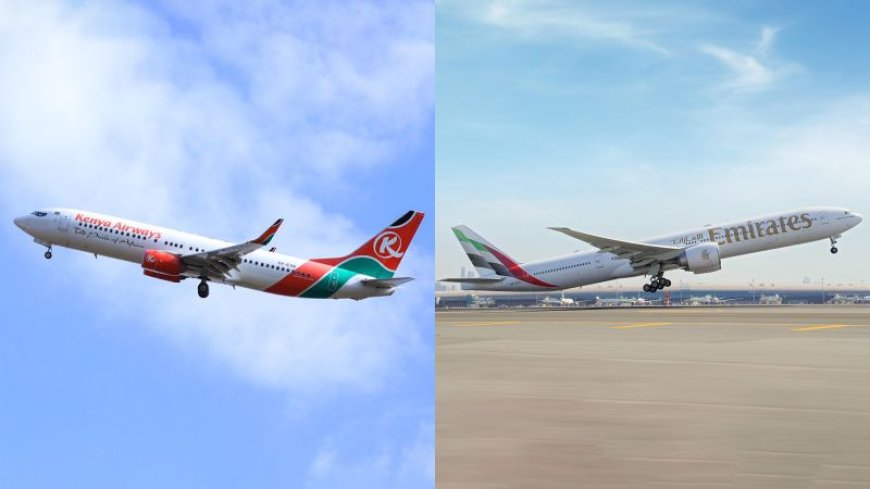KQ, Emirates Face Fresh Competition On Nairobi-Dubai Route After Airline Debuts
The airline will now operate four weekly flights between Dubai and Nairobi and has upgraded its Mombasa service to daily operations, bringing its total flights to Kenya to 11 per week.

Flydubai on Wednesday, October 15, officially launched a new direct service between Dubai and Nairobi, marking a major expansion of the Emirati carrier’s footprint in East Africa and intensifying competition on one of the region’s busiest international routes.
The airline will now operate four weekly flights between Dubai and Nairobi and has upgraded its Mombasa service to daily operations, bringing its total flights to Kenya to 11 per week.
The move strengthens air connectivity between Kenya and the United Arab Emirates (UAE), which has become a vital trade and travel corridor for business, tourism, and cargo.
The inaugural Flydubai flight landed at Jomo Kenyatta International Airport (JKIA) on Wednesday evening to a colourful reception attended by senior officials from the Kenya Airports Authority (KAA). Among those present were Dr. Simon Peter, General Manager for Operations and Safety; Joseph Okumu, General Manager for Security; and Abraham Kipruto, General Manager for Marketing and Business Development.

A Flydubai passenger plane arriving at Jomo Kenyatta International Airport (JKIA) in Nairobi on October 15, 2025. /KENYA AIRPORTS AUTHORITY
Speaking at the ceremony, KAA officials hailed the launch as a milestone that reinforces Kenya’s position as an aviation and business hub for the wider East African region. “This expansion underscores the growing confidence international airlines have in Kenya’s market potential and recovery trajectory,” said Dr. Peter.
A Crowded Sky
Flydubai’s arrival adds to a list of carriers already connecting Nairobi to Dubai, including Emirates and Kenya Airways, all of which operate daily non-stop flights. The airline’s entry injects fresh competition into an already dynamic route, one that serves as a critical link for travelers heading to Asia, Europe, and beyond.
Analysts say the increased capacity could drive down airfares and push existing players to improve their service quality and operational efficiency. “This is a wake-up call for incumbent airlines,” one told Viral Tea.
“Flydubai’s model is cost-efficient, and that gives it room to offer competitive fares while maintaining solid service levels. Kenya Airways and Emirates will likely respond with tactical adjustments on pricing, schedules, and partnerships.”
For travelers, the benefits are immediate — more flight options, flexible schedules, and potentially lower prices. For Kenya’s economy, the expansion is expected to boost tourism, cargo capacity, and foreign investment, aligning with the government’s strategy to enhance global air connectivity.
Betting on Kenya’s Growth
Flydubai’s expansion comes amid a broader wave of new connections to JKIA in 2025, with Gulf Air, Flightlink, Salam Air, TAAG Angola, and Flynas also launching services this year. The surge in interest underscores the strong post-pandemic rebound in Kenya’s aviation and tourism sectors.
Kenya has long sought to position itself as a gateway to Africa, leveraging Nairobi’s strategic location and modernizing its aviation infrastructure to attract more global carriers. The government’s push toward “open skies” policies and regional integration is paying off, with international airlines increasingly viewing Kenya as a launchpad for their African operations.
Flydubai’s entry also expands access to Dubai’s global hub, connecting Kenyan passengers to over 100 destinations worldwide. This is expected to stimulate not just leisure travel but also business links, trade opportunities, and air cargo movement, particularly for high-value exports such as flowers, tea, and technology goods.
Turbulence Ahead
While the increased competition benefits consumers, it also poses challenges for airlines already operating on the route.
The addition of more seats could trigger fare wars if demand does not keep pace with capacity growth. Analysts warn that profit margins could tighten, forcing carriers to differentiate through customer experience, loyalty programs, and value-added services.
Still, industry players see more upside than risk. Kenya’s expanding middle class, strong diaspora links in the Gulf, and rising tourist arrivals continue to sustain demand for air travel between Nairobi and Dubai.
As the inaugural Flydubai aircraft taxied off the runway under a water-cannon salute, it symbolized more than just a new route — it marked the latest chapter in Kenya’s fast-evolving aviation story.
With six international airlines having launched or expanded operations in Nairobi this year alone, one thing is clear: Kenya’s skies are open — and everyone wants a piece of them.







